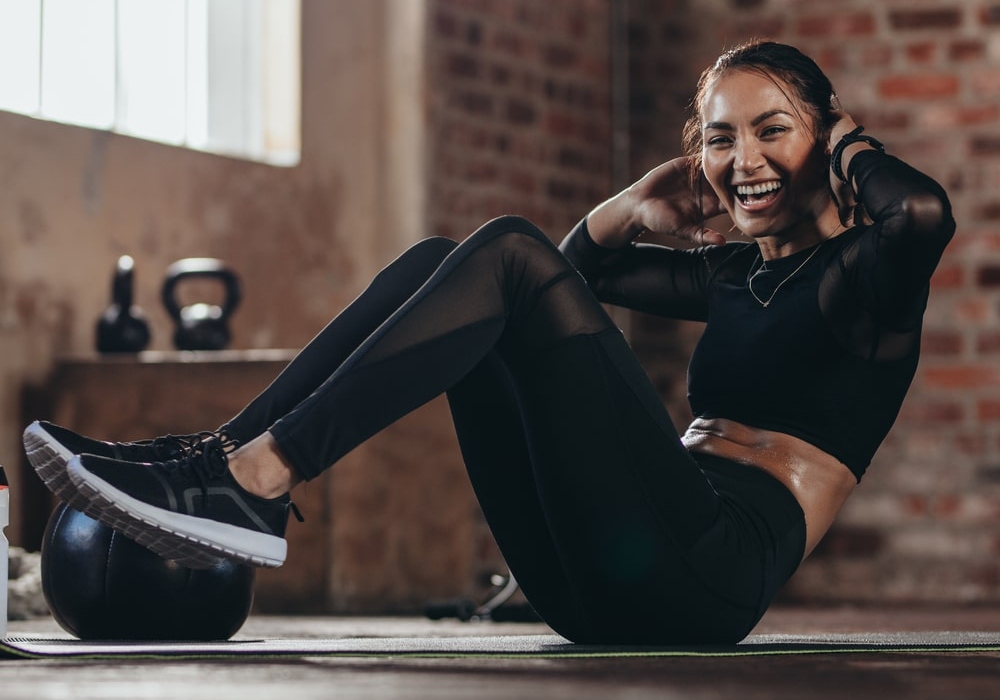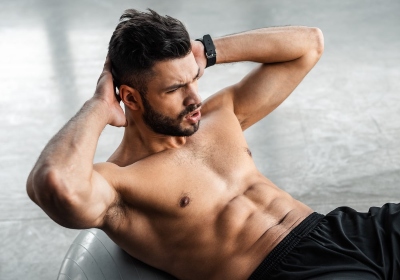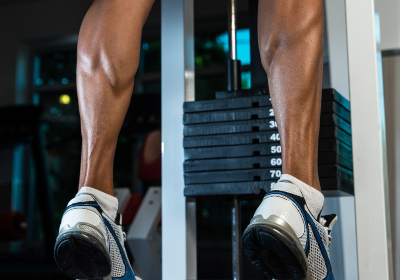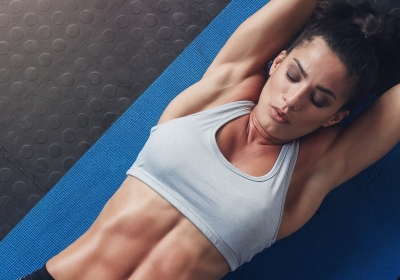VIDEO
Barbell Calf Raise
- Core
- Calves
Level:Intermediate
Trainer:Nick Taylor
Equipment:Barbell
Begin the exercise by standing with your feet shoulder-width apart and the barbell resting across your trapezius. If it is possible stand on the elevated surface, so that your heels are elevated off the ground. Push through the balls of your feet and extend your feet as high as you can. Slowly return to the starting position. Then repeat the exercise.
save to ...
RECOMMENDED FOR YOU
ARTICLES
The oblique abdominal muscles are several groups of abdominal muscles on the sides of the core. The external oblique muscle lies on top and the internal oblique muscle - below it. Functional exercises for training them are bending, turning to the sides, and other rotating movements.
However, in order to work your obliques properly, you must remember that most exercises for the oblique muscles involve the other abdominal muscles, the inner transverse muscles, in particular. That's why you need to be able to consciously engage certain areas of the abs during the workout.
The oblique muscles represent the lateral part of the abdominal area. They act as the main rotators of the body. They are represented by two separate muscles, depending on depth and layer:
The outer oblique abdominal muscle forms the superficial layer. It is usually the target of training. It anatomically begins from ribs 5-12.
The internal muscle originates from the lumbosacral fascia, iliac crest, and inguinal ligament. It is attached to the area of the white line, cartilages of ribs 9-12, and pubic crest.
The main task of the oblique abs is to rotate the torso. Although, in addition to the main one, the muscle performs a number of functions:
Tilting of the torso.
Flexion.
Lowering the ribs.
The tension of the anterior abdominal chest wall.
Bilateral contraction.
In general, in order to work your abs properly, it is necessary to follow simple recommendations:
Eat lightly 2-2.5 hours before the exercise. If you train with an empty stomach, you will not work out to your full potential, which means that the workout will be ineffective. An overfilled stomach can also leave negative consequences, such as nausea and severe dizziness.
Warm up your muscles by doing light exercises. Jump, run on the spot or on a machine, do simple tricks like turns, twists, and turns.
Do not overdo it! You don't need to exhaust yourself every day. Try 2-4 times a week - that will be enough for a nice and shapely belly.
Each exercise should stretch your muscles. You should feel how they are tensed. If this is not there, then you are doing something wrong.
Do not eat immediately after the workout. If you feel very hungry, snack on an apple or drink a glass of water. Do not eat after one hour at the earliest.
Read more
Since ancient times, developed muscles have been one of the hallmarks of a harmoniously developed, athletic body. There is no such thing as 'abs' in anatomy. This is a conditional abdominal muscle. There are four of them:
rectus;
internal oblique;
external oblique and transversus.
The rectus abdominis muscle is the largest in area. It’s a popular fallacy that there is a 'lower' and 'upper' press, but the rectus muscle does not have such a division. The notorious 'six-pack' stands out because of the tendon bridges on the rectus abdominis muscle. The muscle bundles of the external abdominal muscle begin from the lower eight ribs and extend radially downward. The transverse muscle is located deeper than the other abdominal muscles. In this case, the tendon extension in the upper two-thirds passes behind the rectus muscle, and in the lower third - in front. Partly because of this, the lower abs are less workable than the upper ones. The abdominal muscles are referred to as the core muscles, the muscle complex responsible for stabilizing the spine, pelvis, and hips. Each of the abdominal muscles is responsible for its own functions. One of the most common fallacies in abdominal training is that the more reps we do in a set, the stronger and bigger the abs will be. In fact, the muscles of the abs are no different in terms of training from the biceps. To increase the biceps, you will do one hundred reps per set. However, you will reduce the number of sets and reps, but increase the load. By increasing the number of repetitions in the set, you will develop strength endurance, but the muscle will not get thicker from this. It is much more effective to increase the load, do sets with weights and reduce the number of repetitions in the set. Three factors affect the appearance of your abs: posture, body fat percentage, and muscle development.
Posture.If a person pumps muscles but slouches, and he has excess fat, then the abs will not be visible. If a person does not pump the abs, but he has a good posture and a small percentage of body fat, then his belly will look flatter. That is why it makes no sense to start with the question of how to properly pump the abs. You need to start by working on your posture. The good news is that your core muscles are also responsible for correct posture. And they are usually used in workouts with an emphasis on the abs.
Fat percentage.Measuring body composition on an analyzer scale will show the percentage of body fat, which explains why the abs are invisible. If the fat is more than 15-20%, then it’s hard to see your six-pack. At 15% or less, the abs begin to be seen. 8% is abs athletes have. But do not try to completely get rid of fat for beautiful abs. Fat is necessary for the proper functioning of the endocrine system and other processes in the body. To achieve tangible results, it is important to monitor the factors that affect the percentage of body fat like food, sleep, stress levels, and the amount of daily physical activity.
Muscle development.You mustn’t focus only on abs exercises, you need to develop the body complexly and do a variety of activities. Strength training will strengthen your muscles, burn calories and build endurance with interval training. Recovery activities help with posture, flexibility, and muscle balance. The optimal training program can be selected after fitness testing, which takes into account how a person moves, what restrictions he has.
Read more
Building up the calf muscles and make your legs beautiful is quite difficult, but possible. It is difficult because the legs are used to constant strain (usually people walk a lot). And it becomes possible thanks to the proven exercises, which can effectively train this group of muscles. In this article, we will take a detailed look at the anatomy of calves, their functions, and exercises that you can do to help make them stronger.
The calf muscle is the most superficially located muscle of the lower leg that crosses two joints: the knee and ankle. Like the biceps of the shoulder, it consists of two heads: medial (located closer to the inside of the tibia) and lateral (located closer to the outside of the tibia). It is interesting to note, that about 5.5% of Japanese and about 3% of people of other nationalities may have the 3rd head of the calf muscle, which attaches from above between the fixation sites of the medial and lateral heads, and may connect from below either to the lateral head (less often) or to the medial head (more often).
The primary function of the calf muscle is to lift the supporting leg, which causes a person to move forward along with flexion of the knee and ankle joints. Running causes a lot of stress on the calf muscles that is why many sprinters face the problem of calf pain.
There are also other functions of the calf muscle.
The calf muscle is involved in the plantar flexion of the foot, which occurs during walking, running, or cycling;
It is also activated during flexion of the leg at the knee joint;
It participates in the supination of the foot (its outward rotation);
The calf muscle takes part in the stabilization of the knee and ankle joints and also helps to keep the balance in the upright position of the body.
There are many reasons that can cause calf pain. And to prevent this unpleasant situation, the following rules should be followed:
running at a comfortable pace;
warming up before running and stretching after training;
comfortable shoes suitable for running;
a smooth transition from running to stopping after a step;
drinking plenty of water after the workout;
a warm shower/bath and a massage to relax the muscles.
The reasons why the calf muscles are not as developed as you would like them to be could be the following:
too much training aimed at working out this muscle group;
not enough exercise;
the wrong set of exercises.
It is necessary to choose the right exercises for the calf muscles. It must be noted that the surface muscle is worked out in a standing position, and the cambalic muscle in a sitting position. To train as effectively as possible, it is necessary to load both muscles.
And the last, but not the least advice: do not try to achieve serious results by performing endless repetitions, such as deadlifts. The main secret of how to pump up the calf muscles is heavy training with weights. It is recommended to train your calves no more than 2 times a week.
Read more
The core is a series of muscles that start under the pectoral and extend to the pelvis. It also includes several groups in the back and other groups throughout the torso. A 'strong back' means a good physique and a healthy body. If you want to learn how to do this, learn to exercise at home or at the gym. Once you have achieved this strength, you can also learn to maintain it.
The midsection is the area of the body often referred to as the core and it involves everything in that area including the front, back and sides. It includes:
lower back.
the traverse abdominis (TVA);
erector spinae;
obliques;
If they are week it could cause lower back and waist pain. However, taking care of them can keep your posture healthy and make you stronger in other exercises like running and walking.
Training. One of the best core exercises is a plank. It provides minimal movement but maximal effort, demanding you to support your body on your hands and toes during holding your body in a straight line from your shoulders to your ankles. Also, you can rest on your knees If you need it or make it more difficult by extending your arms so you’re supported by your hands.
Bridge. Lie down on the floor. Put your arms straight down on the floor near your hips. Bend your knees. Lift your hips up and down.
Superman. Do a little push-up. Lie with your face down and stretch and arms forward and your legs backward.
V-Jumps. Sit on a bench or chair, lift your legs, tilt the core slightly forward so that your body forms a 45-degree angle. From this position jump up extending your hands above your head.
Pushup Variation. Put your hands and toes on the mat. Keep your arms straight, but don't lock your elbows. Align your feet making the straight line with your arms. Inhaling, lower your chest to the ground slowly. Straighten your arms to lift your core up, exhaling.
Inchworm Variation. Put your hands on the ground and your feet - on the elevated surface (a bench). Start walking your hands out, as far as you can keeping your legs straight throughout the movement. Make a pause. Walk your hands back up to the starting position.
Reverse Crunches Variation. Bend your legs at the knees and brace your abs to slowly raise your legs so that your knees are directly over your hips. Brace abs and hold the neutral spine position with a slight neutral curve in the lower back. Exhale as you contract the abs Your head should be kept straight and relaxed on the mat. Inhale and slowly return to the starting position.
Read more
SAVE TO ...




